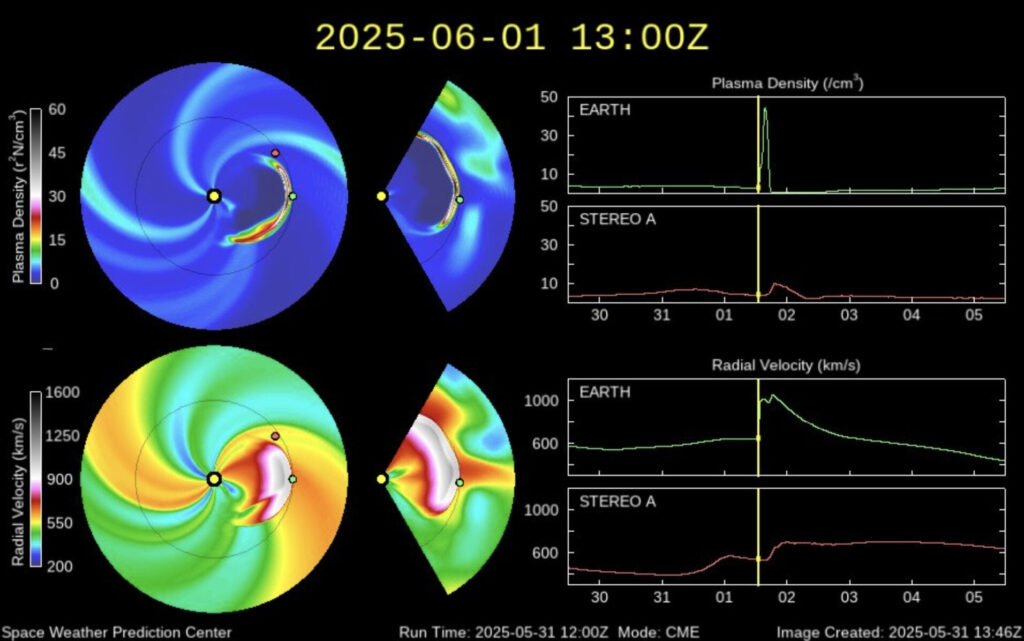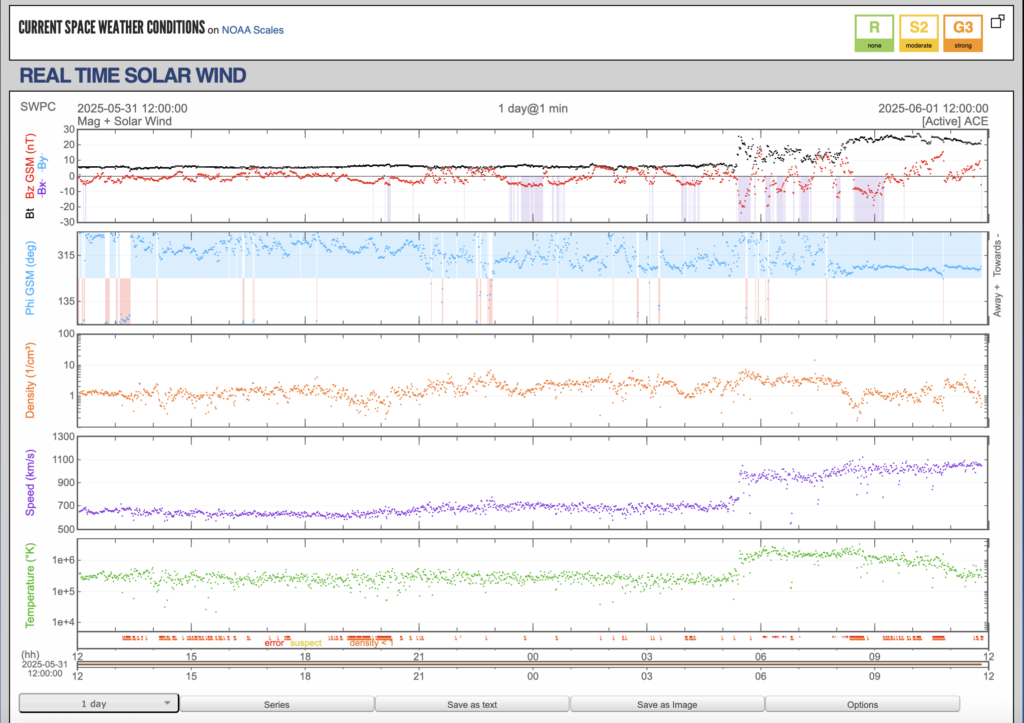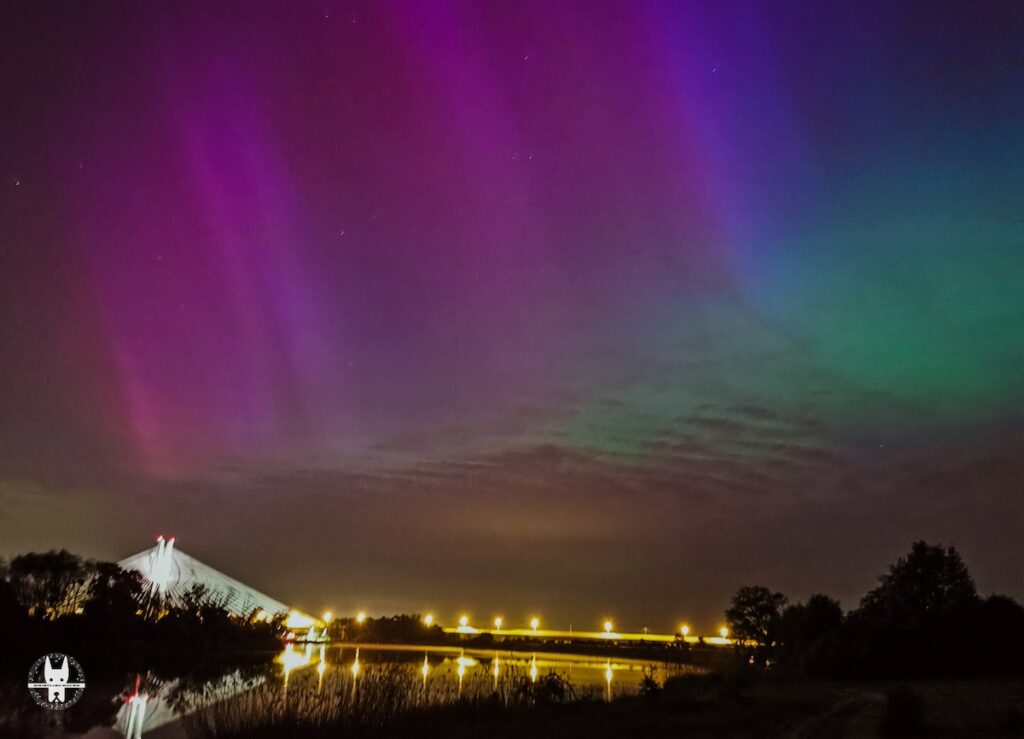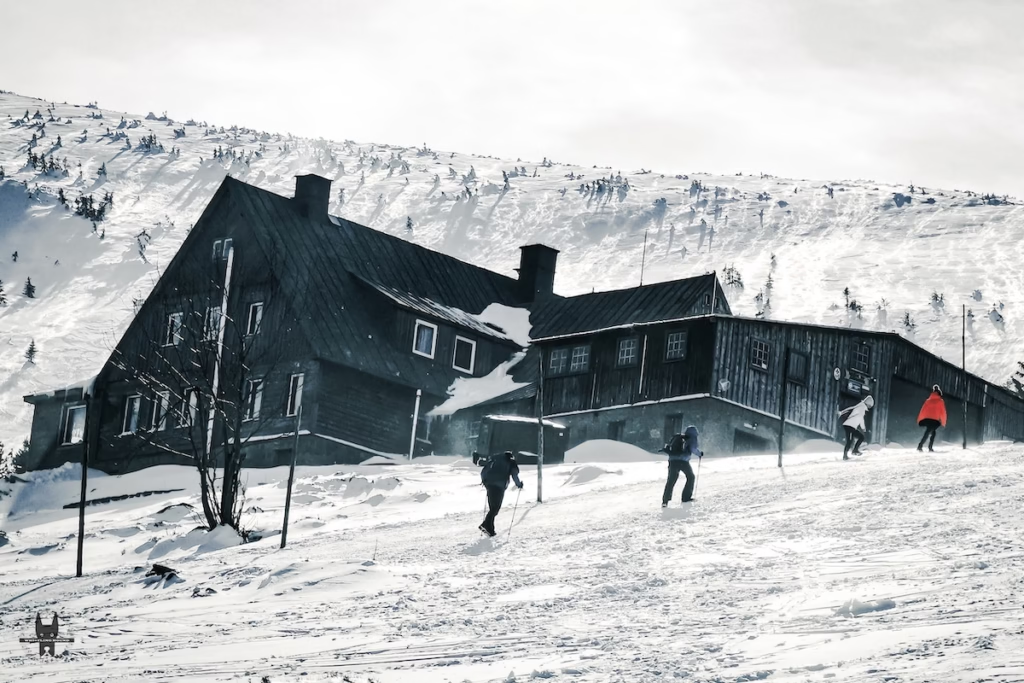The biggest cosmic spectacle of 2025 is brewing! And I’m thrilled yet again.
As of 15:14 CEST on June 1, 2025, a formidable G4-class geomagnetic storm has slammed into Earth, poised to bring a dazzling display of auroras tonight across mid-latitude regions like Poland, significant parts of Central Europe, and later, even northern parts of the USA. A preemptive strike technically hit this morning around 08:00 CEST, roughly eight hours earlier than NOAA’s forecast.
With solar wind speeds surging past 1100 km/s, I’ve got a strong feeling this event could outshine the legendary “Gannon Storm” of 10–11 May 2024, which set skies ablaze from Kraków to Kansas, and rival the electrifying 10–11 October 2024 storm that painted horizons as far south as the U.S.-Mexico border.
Driven by a full-halo Coronal Mass Ejection (CME), tonight’s event might just deliver the biggest geomagnetic storm of 2025. Whether you’re scanning the northern horizon in Gdańsk or chasing a rare glimpse in Chicago, this guide is your ultimate playbook for catching the aurora borealis like a pro. Ditch overhyped KP numbers and outdated apps, and read NOAA forecasts more accurately. I’ve debunked the myths and loaded this guide with real-time tips to help you capture this celestial masterpiece.
What’s Happening? The June 1 2025 Solar Storm Explained
The Science Behind the Spectacle
As of June 1, a full-halo Coronal Mass Ejection (CME), a massive burst of magnetised plasma from the Sun’s corona, has slammed into Earth’s magnetic field. Triggered by an M8.2-class solar flare from Active Region 4100, this CME is on a direct collision course, with models from NOAA, NASA, and ESA predicting impact around 13:00 UTC (15:00 CEST), plus or minus 7 hours. When this plasma cloud hits, it can supercharge the auroral oval, pushing it southward to light up skies in places like Poland, Germany, and even central France.
Why June 1 2025, Solar Storm Matters for Europe?
Unlike many aurora forecasts that focus on North America, this storm’s timing favours Europe, particularly Central Europe. The CME is expected to hit in the afternoon (CEST), with auroral activity potentially peaking as darkness falls over Poland and neighbouring countries. For the USA, the timing is less ideal (morning to midday local time), but prolonged geomagnetic activity could still bring auroras to northern states by nightfall.
Aurora Forecast for Poland & Central Europe: When and Where to Look June 1 solar storm 2025
Timing for Poland (CEST)
- Impact Window: 15:00–22:00 CEST, June 1, 2025
- Prime Viewing Time: 22:00 CEST to 02:30 CEST, assuming geomagnetic activity persists into the night
- Key Tip: Substorms, short, intense bursts of auroral activity (30–60 minutes), often peak after midnight, so stay patient!
Best Locations in Poland to Capture June 1 2025 Solar Storm
- High Odds: Northern regions like Gdańsk, Suwałki, and Olsztyn, where the auroral oval is closest.
- Moderate Odds: Warsaw, Poznań, Łódź—look low on the northern horizon.
- Possible Southern Views: If the storm’s magnetic field (Bz) stays southward, Kraków and Wrocław could see faint auroras low in the sky.
Visibility Across Europe and the USA
- Central Europe: Germany, Czechia, and southern Scandinavia have strong chances, especially in dark, rural areas.
- Western Europe: Northern France, the UK, and Ireland may catch low-horizon auroras during substorms.
- USA: Northern states like Washington, Minnesota, and Maine could see auroras if activity lasts into the evening (21:00–02:00 local time). During strong substorms, states as far south as Colorado or Pennsylvania might get a glimpse, similar to October 2024’s displays.
Debunked: Why the KP Index Won’t Predict Your Aurora Adventure
The KP Index Trap
You’ve probably heard that a high KP index (like the predicted KP 8) guarantees auroras. Wrong. The KP index is a delayed, model-based metric that’s often misleading for real-time aurora chasing. Think of it like using a three-day weather forecast to decide if it’s raining right now—it’s not reliable.

Real-Time Solar Wind Metrics That Matter
To know when and where auroras will appear, focus on these live data points:
- Bz Component: A southward (negative) Bz below –5 nT allows energy to flow into Earth’s magnetic field, boosting auroras.
- Solar Wind Speed: Above 600 km/s indicates a strong storm.
- Proton Density: 10+ protons/cm³ means the CME is compressing Earth’s magnetosphere, enhancing auroral displays.
- AE Index: Values over 1000 nT signal active substorms, which drive vivid aurora bursts.
Storms vs. Substorms: What’s the Difference?
- Geomagnetic Storm: A global, hours-long event caused by a CME impacting Earth’s magnetic field.
- Substorm: A short, localised burst (30–60 minutes) that creates intense, colourful auroras. These are your best bets for jaw-dropping photos.

How to Track the June 1 2025 Solar Storm Like a Pro?
Essential Apps for Aurora Chasers
Forget generic weather apps, use these Europe-friendly resources:
- SpaceWeatherLive: Real-time data on solar wind, Bz, and magnetometers.
- Windy.com: High-resolution cloud cover forecasts for Poland and Europe.
- NOAA DSCOVR Data: Hardcore metrics for solar wind and magnetic field.
- Webcams: Check live feeds from Gdańsk, Kiruna (Sweden), or Tromsø (Norway) via aurora.live or skylinewebcams.com.
Finding the Perfect Spot
- Dark Skies: Use lightpollutionmap.info to find low-light-pollution areas. Rural spots north of cities like Warsaw or Gdańsk are ideal.
- Clear View North: Ensure no buildings or hills block the northern horizon, where auroras appear.
- Weather Check: Confirm clear skies with Windy.com, as auroras shine above clouds.
Photographing the Aurora: Tips for Stunning Shots
Even if the aurora looks faint to the naked eye, your camera can reveal its vibrant colours. Here’s how to capture the magic:
- Camera Settings:
- ISO: 1600–3200 for low-light sensitivity.
- Shutter Speed: 6–15 seconds to capture auroral motion.
- Aperture: f/2.8 or wider for maximum light.
- Focus: Manual, set to infinity.
- Gear: A sturdy tripod is essential to avoid blurry shots.
- Pro Tip: Shoot north-northeast and look for red auroras, which often appear further south. Use your camera’s screen to confirm faint auroras not visible to the eye.
Beyond the Celestial Show: Solar Storms and Real-World Impacts
The June 1, 2025, solar storm isn’t just about dazzling auroras; it disrupts tech we rely on. GPS and RTK glitches could delay wheat and barley tasks in Poland or soybean planting in the USA, like the May 2024 Gannon Storm. Polar flights and satellite comms may face hiccups, and while G4 storms stress power grids, modern safeguards usually hold.
FAQs: Your Aurora Questions Answered
Q: Can I see auroras from Warsaw or Kraków?
Yes, if the storm persists into the evening and Bz remains southward. Look low on the northern horizon, especially during substorms.
Q: What’s the best time to watch in Poland?
Start checking from 21:30 CEST on June 1, staying out past midnight for peak substorm activity.
Q: Do I need a KP 9 for auroras in mid-lower latitudes?
No. A strong southward Bz and high solar wind speed are more important than KP. KP 8 is impressive, but not the whole story.
Q: Can I see auroras with the naked eye?
Yes, faint green or red bands may be visible, especially in dark areas. Cameras reveal more vibrant colours.
Q: How long will the storm last?
Strong storms can last 12–24 hours, but auroral displays are most intense in the first 6–12 hours after impact.
Q: Will the USA see auroras too?
Northern states have a chance if activity persists into the evening (21:00–02:00 local time). Substorms could push auroras as far south as Colorado or Pennsylvania.
Your Aurora-Chasing Checklist
- Clear Skies: Verify with Aurora or Windy.com app.
- Dark Location: Use lightpollutionmap.info to find a spot with minimal light pollution.
- Northward View: Ensure an unobstructed northern horizon.
- Real-Time Data: Monitor SpaceWeatherLive for solar wind and Bz updates.
- Camera Ready: Charge your phone or camera, and bring a tripod.
- Timing: Know your local sunset (Poland: ~21:00 CEST).
- Enjoy the Moment: Don’t get lost in data, savour the cosmic wonder!
Share the Magic: Join the Aurora Community
If you catch the aurora in Poland, Europe, or even the USA, share your photos and stories with me! Tag me on Instagram
@whistlinghound
Or send a message via my contact form at whistlinghound.com/contact. I’ll be sharing live updates and tips on social media as the storm unfolds, so follow along to stay in the loop. Let’s celebrate this rare sky show together and inspire others to look up!
Further read: Explaining the Historical Geomagnetic Storm of 10th May 2024 – The Day Earth Lit Up with Red Auroras
Share this:
- Click to share on Facebook (Opens in new window) Facebook
- Click to share on LinkedIn (Opens in new window) LinkedIn
- Click to share on Reddit (Opens in new window) Reddit
- Click to share on X (Opens in new window) X
- Click to share on WhatsApp (Opens in new window) WhatsApp
- Click to email a link to a friend (Opens in new window) Email





